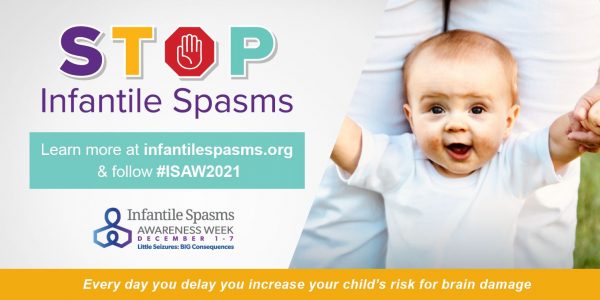Epilepsy Alliance America supports Infantile Spasm Awareness Week – December 1-7, 2021

Epilepsy Alliance America is a proud member of the Infantile Spasms Action Network (ISAN) – a collaborative network of 30+ national and international entities dedicated to raising awaress for IS. ISAN is convened by Child Neurology Foundation.
ABOUT INFANTILE SPASMS
Infantile spasms (IS) are a rare, but serious type of seizure, occurring in one in 2,000 children, which can cause catastrophic, permanent damage to a child’s developing brain.
The seizures include repetitive, but often subtle movements — including jerking of the mid-section, dropping of the head, raising of the arms or wide-eyed blinks.
The onset of IS peaks between four and six months of age, although these seizures can begin anytime in the first two years.
Infantile spasms are often overlooked or misdiagnosed for other conditions, including colic, reflux, or a startle reflex.
Worldwide, it is estimated a baby is diagnosed with IS every 12 minutes.
FOR CAREGIVERS AND PARENTS
It’s critical to remember infantile spasms are a medical emergency that should never be taken lightly.
If you suspect your child may be showing symptoms of infantile spasms, inform your doctor immediately. Any delay in seeking emergency treatment can increase your child’s risk for brain damage.
Soon after the spasms begin, children may stop making developmental progress or even lose skills they had previously acquired, causing significant cognitive disabilities if left untreated.
If caregivers believe their concerns are being overlooked, they should pursue a second opinion at a TSC clinic, a Comprehensive Pediatric Epilepsy Center, or from a neurologist with expertise in treating IS.
Though infantile spasms may not look “dramatic,” they can have serious, life-long effects if not treated quickly. Do not hesitate to contact your doctor if you see possible symptoms of infantile spasms.

Follow the mnemonic tool ‘STOP’:
See the signs: Clusters of sudden, repeated, uncontrolled movements like head bobs or body crunching.
Take a video: Record the symptoms and talk to your doctor immediately.
Obtain diagnosis: Confirm an irregular brain wave pattern with an EEG test.
Prioritize treatment: End spasms to minimize developmental delays.
Learn more by visiting the Infantile Spasms page.
Learn more by visiting the Infantile Spasms Action Network (ISAN) website.
